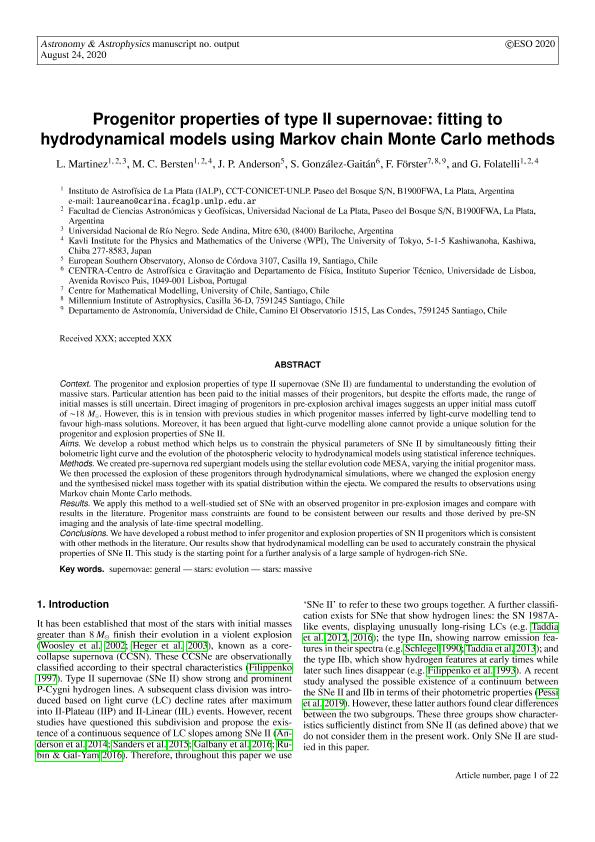Artículo
Progenitor properties of type II supernovae: fitting to hydrodynamical models using Markov chain Monte Carlo methods
Martinez, Laureano ; Bersten, Melina Cecilia
; Bersten, Melina Cecilia ; Anderson, J. P.; González Gaitán, S.; Förster, F.; Folatelli, Gaston
; Anderson, J. P.; González Gaitán, S.; Förster, F.; Folatelli, Gaston
 ; Bersten, Melina Cecilia
; Bersten, Melina Cecilia ; Anderson, J. P.; González Gaitán, S.; Förster, F.; Folatelli, Gaston
; Anderson, J. P.; González Gaitán, S.; Förster, F.; Folatelli, Gaston
Fecha de publicación:
08/2020
Editorial:
EDP Sciences
Revista:
Astronomy and Astrophysics
ISSN:
0004-6361
Idioma:
Inglés
Tipo de recurso:
Artículo publicado
Clasificación temática:
Resumen
The progenitor and explosion properties of type II supernovae (SNe~II) are fundamental to understanding the evolution of massive stars. Particular attention has been paid to the initial masses of their progenitors, but despite the efforts made, the range of initial masses is still uncertain. Direct imaging of progenitors in pre-explosion archival images suggests an upper initial mass cutoff of $\sim$18~\ms. However, this is in tension with previous studies in which progenitor masses inferred by light-curve modelling tend to favour high-mass solutions. Moreover, it has been argued that light-curve modelling alone cannot provide a unique solution for the progenitor and explosion properties of SNe II. We develop a robust method which helps us to constrain the physical parameters of SNe~II by simultaneously fitting their bolometric light curve and the evolution of the photospheric velocity to hydrodynamical models using statistical inference techniques. We created pre-supernova red supergiant models using the stellar evolution code MESA, varying the initial progenitor mass. We then processed the explosion of these progenitors through hydrodynamical simulations, where we changed the explosion energy and the synthesised nickel mass together with its spatial distribution within the ejecta. We compared the results to observations using Markov chain Monte Carlo methods. We apply this method to a well-studied set of SNe with an observed progenitor in pre-explosion images and compare with results in the literature. Progenitor mass constraints are found to be consistent between our results and those derived by pre-SN imaging and the analysis of late-time spectral modelling. We have developed a robust method to infer progenitor and explosion properties of SN II progenitors which is consistent with other methods in the literature. Our results show that hydrodynamical modelling can be used to accurately constrain the physical properties of SNe~II. This study is the starting point for a further analysis of a large sample of hydrogen-rich SNe.
Palabras clave:
SUPERNOVAE: GENERAL
,
STARS: EVOLUTION
,
STARS: MASSIVE
Archivos asociados
Licencia
Identificadores
Colecciones
Articulos(IALP)
Articulos de INST.DE ASTROFISICA LA PLATA
Articulos de INST.DE ASTROFISICA LA PLATA
Citación
Martinez, Laureano; Bersten, Melina Cecilia; Anderson, J. P.; González Gaitán, S.; Förster, F.; et al.; Progenitor properties of type II supernovae: fitting to hydrodynamical models using Markov chain Monte Carlo methods; EDP Sciences; Astronomy and Astrophysics; 642; A143; 8-2020; 1-21
Compartir
Altmétricas



